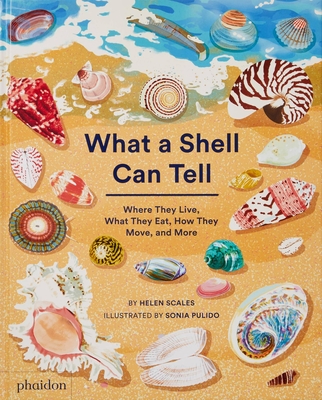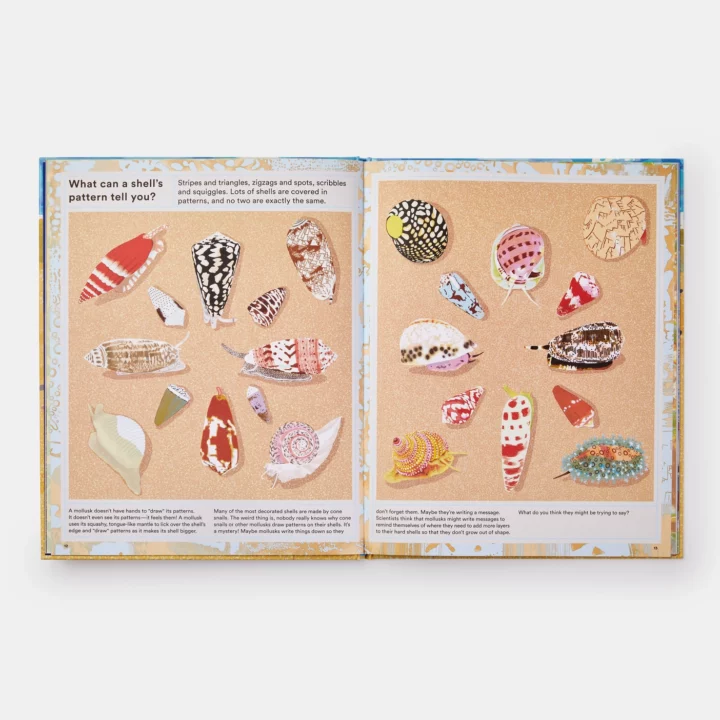
WHAT A SHELL CAN TELL
How They Live, What They Eat, How They Move, and More
By: Helen Scales
Illustrated by: Sonia Pulido
Published: June 15, 2022
Publisher: Phaidon Press
Non-Fiction
In preparation for my trip to the beach next week, I was excited to read this book and learn all about shells that I might find in my walks along the ocean. Even though this book is targeted at elementary to middle-school-aged kids, I found so much to learn in this book.

Over the years, I’ve collected jars of shells that I have displayed around our home. It is always a thrill to find a unique color or pattern during my morning walk on the beach. Especially because there is really nothing like that in the area where I live. I have some favorite shells that I’ve found over the years, but I never really thought about the reason behind their color or pattern.
Dr. Helen Scales is an award-winning marine biologist. Her learning approach in this book immediately engages kids to want to know the answers to the questions she poses. What is a shell? It is a home for mollusks, or soft animals that have no bones, and need protection. When the mollusk is born, the shell is tiny, but it grows as the mollusk grows and layer upon layer is added for protection. When the mollusk dies, the shell is left behind. This is why it is crucial to make sure the shell is empty before you take it home.
No two shells are exactly the same even though I have many similar ones. But, when I find a unique spiral shell or one with a pretty pattern, I get excited. Those patterns are a bit of a mystery. Scientists wonder if the mollusk is trying to write a message to themselves in the pattern much like we write a to-do list. For many, their colors and patterns relate to another layer of protection, naturally camouflaging them in their environment.
Some mollusk shells can tell us their age, much like a tree. Scientists using a microscope can count the layers of the shell to determine its age. Many are only a few years old, but the quahog can live for 500 years on the bottom of the ocean. Obviously, not all shells come from the sea. Snails can live in our backyards or forests and leave their shells behind.
The richly-colored and detailed illustrations in this book along with the brief paragraphs of facts will entice kids to want to study the previous shells they’ve collected on trips to the beach. I found this book to be extremely informative and fascinating and can’t wait to do my own searching next week on the Atlantic Ocean.
The end of the book discusses the changes happening in our oceans and on our beaches related to pollution and how that can affect mollusks. There is also a guide for studying your own shells with pictures to match them up. A map of the world shows the best places to find certain shells. Overall, this book is a great resource if your family likes to collect shells or wants to learn more about the shells in your collection.
Dr. Helen Scales is a marine biologist, writer, and documentary maker focusing on connections between people, science, and the living world. She is the author of the Guardian bestseller Spirals in Time and writes for National Geographic Magazine, the Guardian, and New Scientist, among others. She teaches at Cambridge University and is a science advisor for the marine conservation charity Sea Changers.
Sonia Pulido is an artist living in a seaside village close to Barcelona. Her illustrations have appeared in publications globally, including The New Yorker and The New York Times.
To purchase a copy of WHAT A SHELL CAN TELL, click the photo below:

Other posts you might like:
Thanks to the publisher for sending a copy of this book for the purpose of this review. This review is my honest opinion. If you choose to make a purchase through the above links, I may receive a small commission without you having to pay a cent more for your purchase.
Posted Under beach, Book Review, Children's books, Helen Scales, non-fiction, ocean, shells, Sonia Pulido
